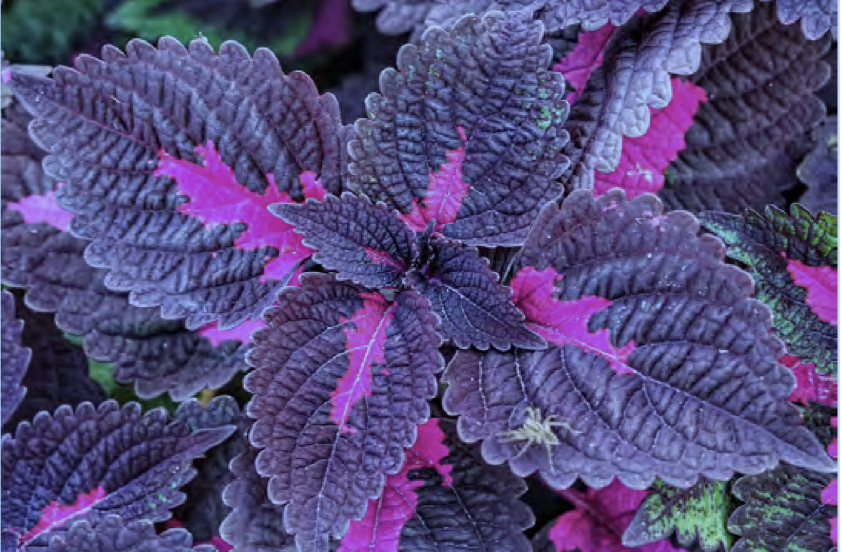
HCMG Herb of the Month: Perilla
By Karen McGowan, Master Gardener
Perilla frequently pops up in southeast Texas nurseries and garden centers, often referred to by its alternate names, “purple shisho” and also “beefsteak plant,” the latter of which comes from its fragrant purple-red leaves that can resemble raw meat. Perilla’s genus name is derived from the Latin word “pera,” meaning bag in reference to the shape of the fruiting calyx, while the specific epithet “frutescens” means shrubby or bushy.
A colorful member of the Lamiaceae (mint) family, perilla is native to the Himalayas and Southeast Asia, and has been used both as an edible and for medicinal purposes wherever it is grown for hundreds of years. The leaf, stem, and seed are used to make medicine. Perilla is used for canker sores, airway illnesses, stomach issues, and other conditions; however, there is no scientific evidence to support any of these uses. In foods, perilla is used as a flavoring, in tea, and to prevent fish and crab poisoning. Since I’ve only rarely heard of fish or crab poisoning, perhaps perilla is very effective in these uses?
In manufacturing, perilla seed oil is used commercially in the production of varnishes, dyes, and inks. According to the internet source WebMD, Perilla contains chemicals that might decrease swelling and affect other chemicals that cause asthma and allergy symptoms. WebMD also states that “some chemicals in perilla might kill cancer cells,” but no scientific study citation is provided to support this statement.
On a governmental website, however, there are other claims that are supported by a study: the National Library of Medicine/National Center for Biotechnology Information in 2018 published information gleaned from an obesity study of laboratory mice. The conclusion states that “[p]urple perilla (PE) is a medicinal plant that has several health benefits.” In the study, the anti-obesity effect of perilla was evaluated in mice that were fed high-fat diets. It was revealed that perilla reduced lipid accumulation. Treatment with perilla “significantly prevented body weight gain, improved serum lipids, hepatic lipids and reduced the epididymal fat” in mice that were fed high-fat diets. The results “suggested that PE (purple perilla) has anti-obesity effects in rodents and can be effective in obesity management.” Other articles imbedded within the NLM’s website from previous, similar studies reflect agreement with these findings.
The trouble with perilla is that it grows very aggressively and has been classified in some areas as “invasive.” With no serious insect or disease issues that would represent a threat to the
plant, together with an aggressive growth habit and prolific self-seeding, perilla – true to its mint-family nature – can easily become a garden pest in and of itself. North Carolina State’s Extension website offers on perilla that “it is found growing along roadsides and disturbed areas growing into natural spaces outcompeting endemic plants.” North Carolina’s extension office is making the statement, but this sounds like any number of plants I have heard of as “growing in asphalt cracks in Florida.” A rabbit trail question: Why is it seemingly always Florida where invasive biological things either start or take off like wildfire? The state of Florida is apparently like a lab beaker set over constantly ideal developmental conditions.
Since perilla represents one of those perfect plant storms for invasiveness, it can pounce into adjoining areas like a garden lion and take over, so plant with caution. For some tall fall color to contrast against ubiquitous, Margarita sweet potato vine and orange pumpkins, though, it may be nice! Happy October, everyone!
Source: Harris County Master Gardeners Urban Dirt Newsletter (October 2022 Edition)
About Urban Dirt
Each month, Harris County Master Gardeners publishes an informative, resourceful newsletter entitled "Urban Dirt". This article was derived from the October 2022 edition. To read the October 2022 edition of this newsletter, click the button below.









